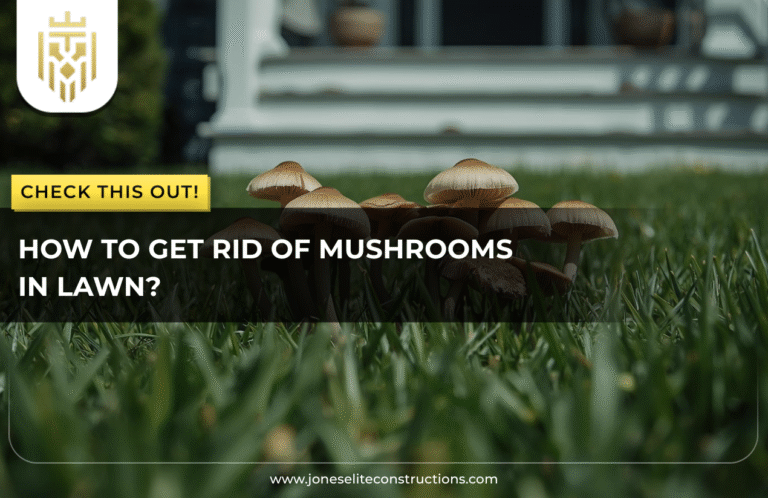How to Unclog a Drain
Learning how to unclog a drain can become an urgent issue for a homeowner whose sinks or tubs drain slowly. Frightening as it may sound, the vast majority of clogs can be unclogged at home with means accessible to everyone, such as baking soda and hot water, rather than turning to harsh chemicals or a plumber right away.
What Causes Drain Clogs?
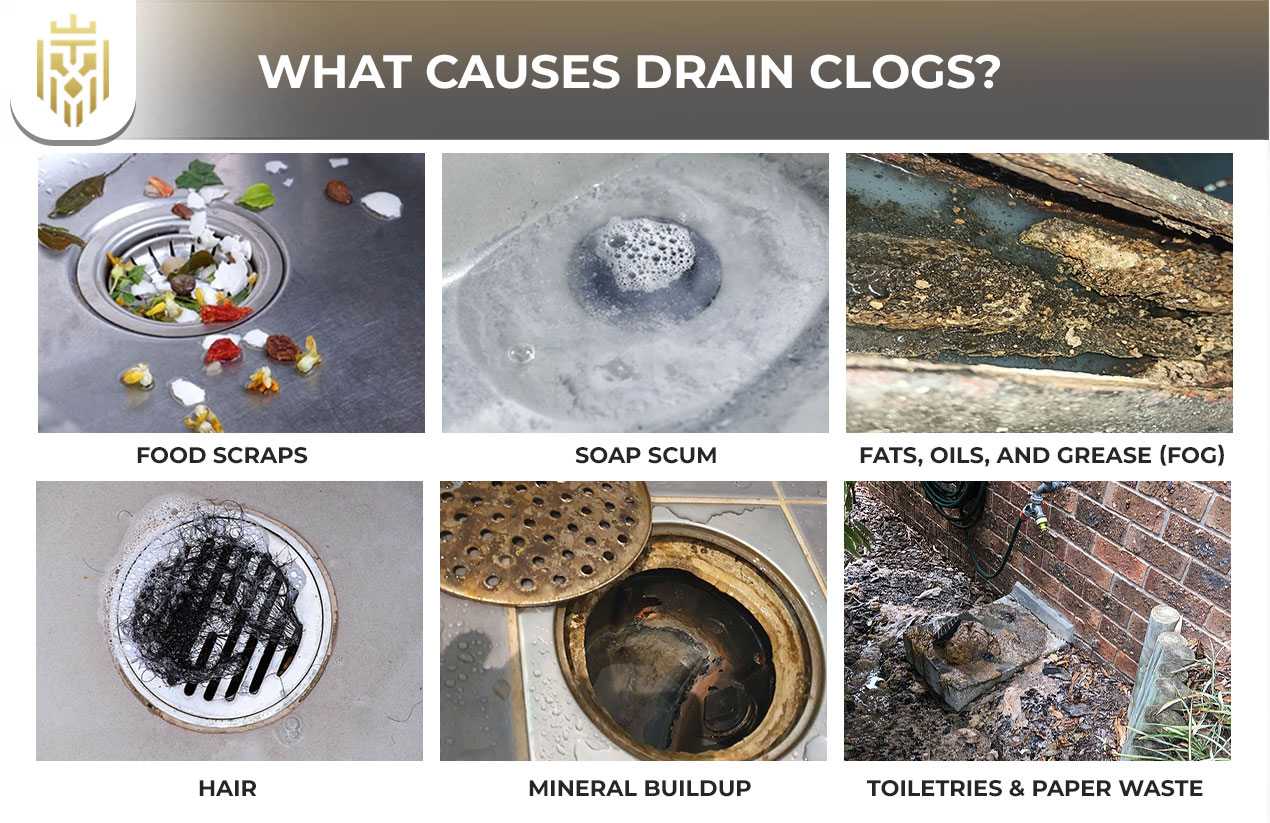
Organic and inorganic materials tend to combine and cause drain clogs. Gross hair, soap scum, food, and grease can build up and clog the water flow. Being aware of the cause is one method of identifying the most appropriate method of clearing a drain fast and preventing a future occurrence.
Food Scraps
Kitchen sinks receive leftover food particles that make them sticky. The coffee grounds, rice, and eggshells should not go down the drain. In case of clogs, it is better to think of eco-friendly solutions like baking soda and vinegar before you resort to a drain cleaner.
Soap Scum
The scraps of soap may dry out over a period, forming clumps that attach to the interface of the pipes, trapping rubbish. Toilet runoffs are typical of this problem in the bathroom drains. To learn how to unclog a shower drain entails tackling solidified scum, hot water, and baking soda, which would be an excellent cleanser and solvent to loosen the solidified scum.
Fats, Oils, and Grease (FOG)
The FOG from frequent cooking will leave the pipe’s interiors covered and trap food particles, causing stubborn clogs. Instead, pour down some boiling water in the drain now and then to aid in grease breakdown and keep your kitchen sink running free.
Hair
One of the most frequent clogs is caused by hair clumps and is seen most of the time in showers and bathtubs. Unclogging a bathtub drain tends to begin with physically picking out the hair with a hook or Zip-It and then proceeding to utilize a drain cleaner.
Mineral Buildup
The minerals deposited in the pipes by hard water may lead to a narrowing of the water passage. This, in the long run, contributes to slow draining. A homemade solution, such as baking soda and vinegar, is effective in breaking up some of the buildup and is not as harsh as regular chemicals.
Toiletries & Paper Waste
Wipes, cotton swabs, or tissues, when flushed down the toilet, block bathroom drainpipes. When it takes a long time to get the water drained, it is beneficial to know how to unclog a sink drain or toilet with a plunger or drain snake before incurring expensive damage costs.
Ways to Unclog a Drain – General Tips
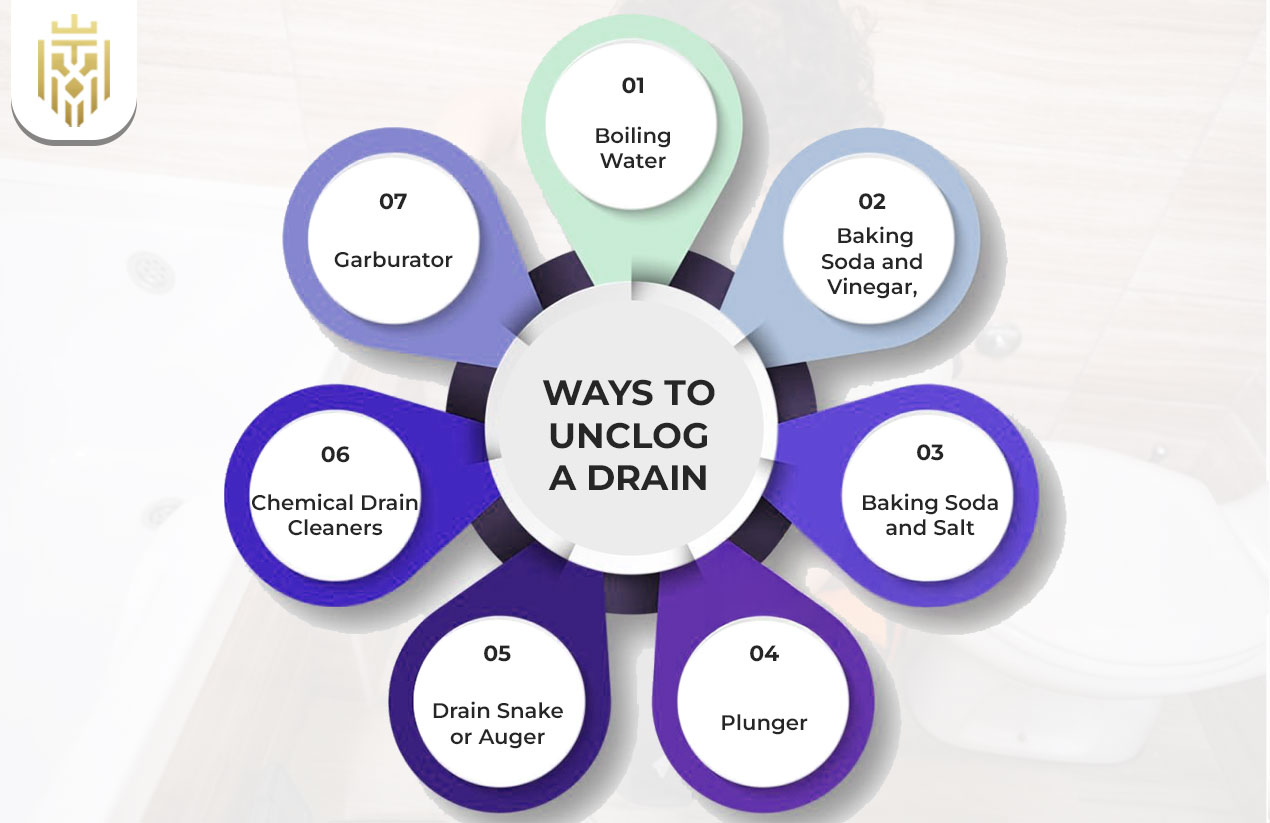
You do not always require professional assistance when it comes to dealing with a clog. Begin with common methods such as pouring hot water, plunging, or using baking soda and vinegar. These are confident and cheap methods to deal with minor concerns without ever relying on harsh chemicals.
Boiling Water
A continuous flow of boiling water can be poured to melt greasy deposits or dislodge soft blockages. A basic but efficient technique that may be utilized in most situations can be the start of your training in learning how to clear a drain through natural means, prior to bringing in any of the chemical methods of clearing the drainage.
Baking Soda and Vinegar
This traditional combination, resulting in the formation of a fizzy reaction, displaces the grime and the debris. Perfect to unclog sinks and showers, it is an environmentally responsible way to unclog a drain without having to rely on harsh chemicals to clean your pipes and keep our environment safe.
Baking Soda and Salt
Another natural way is to combine baking soda with salt, leave it, and then flush with warm water. That coarse-grained content is used to scrub the walls of a plumbing pipe to loosen up minor clogs without damaging the pipes, as some of the chemical drain cleaners do.
Plunger
With the help of a plunger, the blockage is suctioned out. Its application proves useful in sinks, tubs, and toilets. A proper plunging technique is another thing to know when learning how to unclog a sink drain or toilet without having to take apart any plumbing component.
Drain Snake or Auger
A drain snake or auger can potentially physically burst through hard stoppages, whereas other methods are not able to. The tool is particularly useful when you have to clean hair or debris in hard-to-access areas, including the deepest points of a bathtub drain.
Chemical Drain Cleaners
The products that work as drain cleaners dislodge grime and accumulation. They are effective, but are usually toxic to pipes, as they have harsh chemicals. Use them as the last alternative and observe safety instructions to prevent harm and health issues.
Garburator
In case you have a garbage disposal in your kitchen sink, then put cold water while flushing it. Do not place fibrous or starchy items into it. Cleaning regularly using baking soda can ensure that odors are kept to a minimum and there is no need to unclog a drain in the future.
How to Unclog a Shower Drain?
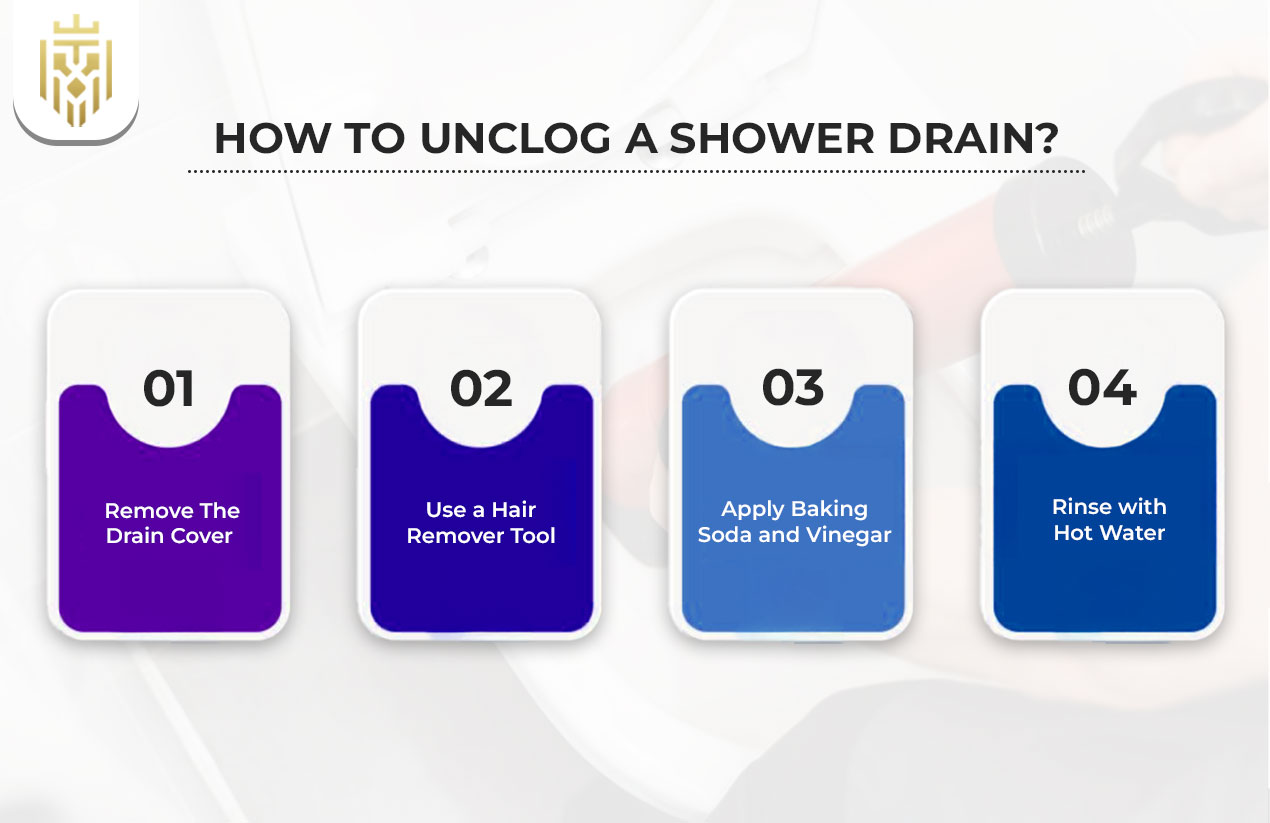
Soap scum and hair frequently clog the shower drain. The unclogging of a shower drain can be done manually and using chemicals, which includes getting rid of what is visible, using a snake, and applying baking soda to perform the necessary maintenance and arrest the odor that it causes.
Remove the Drain Cover
Allow the beginning by screwing off or pulling the shower drain cover. This opens up visible blocks like hair and gunk. The first physical process in grasping how to unclog a shower drain in a proper and hygienic way is the removal of the cover.
Use a Hair Remover Tool
The clumps of hair can be plucked out with the help of a plastic hook or a Zip-It tool. This is one of the easiest things you can do to avoid using harsh chemicals and is a key shower cleaning trick that is needed in general when you have a lot of issues with hair buildup.
Apply Baking Soda and Vinegar
Adding baking soda and then vinegar down the drain of the shower easily removes soap scum and other organic matter. It is among the most effective ways of trying to unclog a shower drain using the best natural ways possible without destroying your plumbing system.
Rinse with Hot Water
Flush the drain using hot water after cleaning or the use of natural solutions, so as to make sure everything is washed away. This also assists in cleaning up excess residue and makes your shower drain run clean regularly.
How to Unclog a Sink Drain?
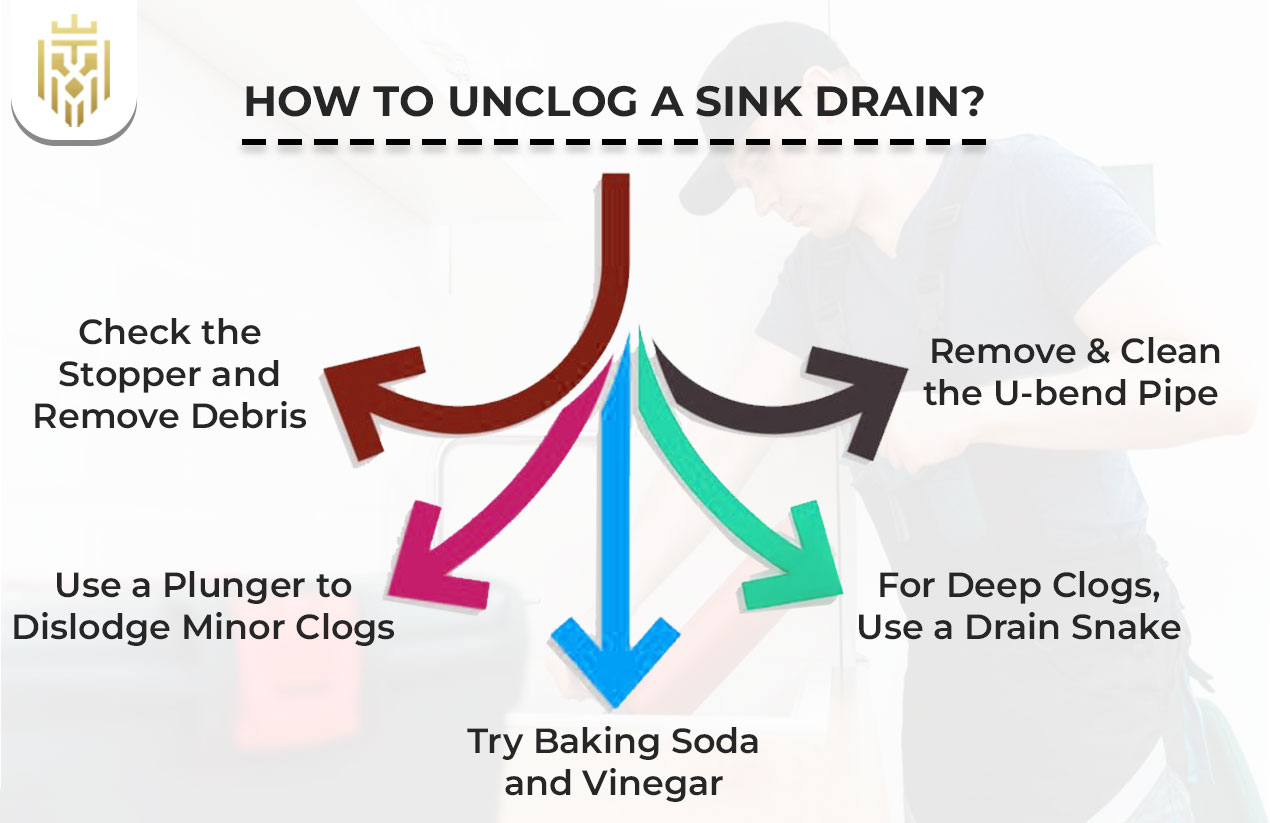
Being able to unclog a sink drain is a kitchen/bathroom must for anyone. Use items like plungers, baking soda, and a drain snake to clear food or hair blockage based on where the sink is and the kind of clog.
Check the Stopper and Remove Debris
Sometimes, blockages occur around the stopper. Take it off and rinse off hair or soap scum. This easy repair can get water flowing again rapidly without having to use a drain cleaner or take apart any pipes, especially on bathroom sinks.
Use a Plunger to Dislodge Minor Clogs
Pour water into the overflow hole and plunge steadily to dispose of small clogs. This trick is a good means to know how to unclog a sink drain without damaging the pipes so as not to use some kind of harsh chemicals.
Try Baking Soda and Vinegar
Pour baking soda into the drain over vinegar, then cover and let it sit there for 15 minutes. Rinse with hot water after that. This natural action works to break down the grease and organic stuff without the need for a high-priced drain cleaner.
For Deep Clogs, Use a Drain Snake
Feed the drain snake down into the pipe so it gets a good grip on the debris, and twist it. This method is best to use when the clog is too far to access and too strong for baking soda or a hot water solution to handle.
Remove & Clean the U-bend Pipe
Get a bucket under it, unscrew the U-bend, and manually dive in and clean out the clog. This step is essential if all of the other methods to unclog a drain do not work, in particular, in kitchen sinks where grease and food debris tend to collect.
How to Unclog a Bathtub Drain?
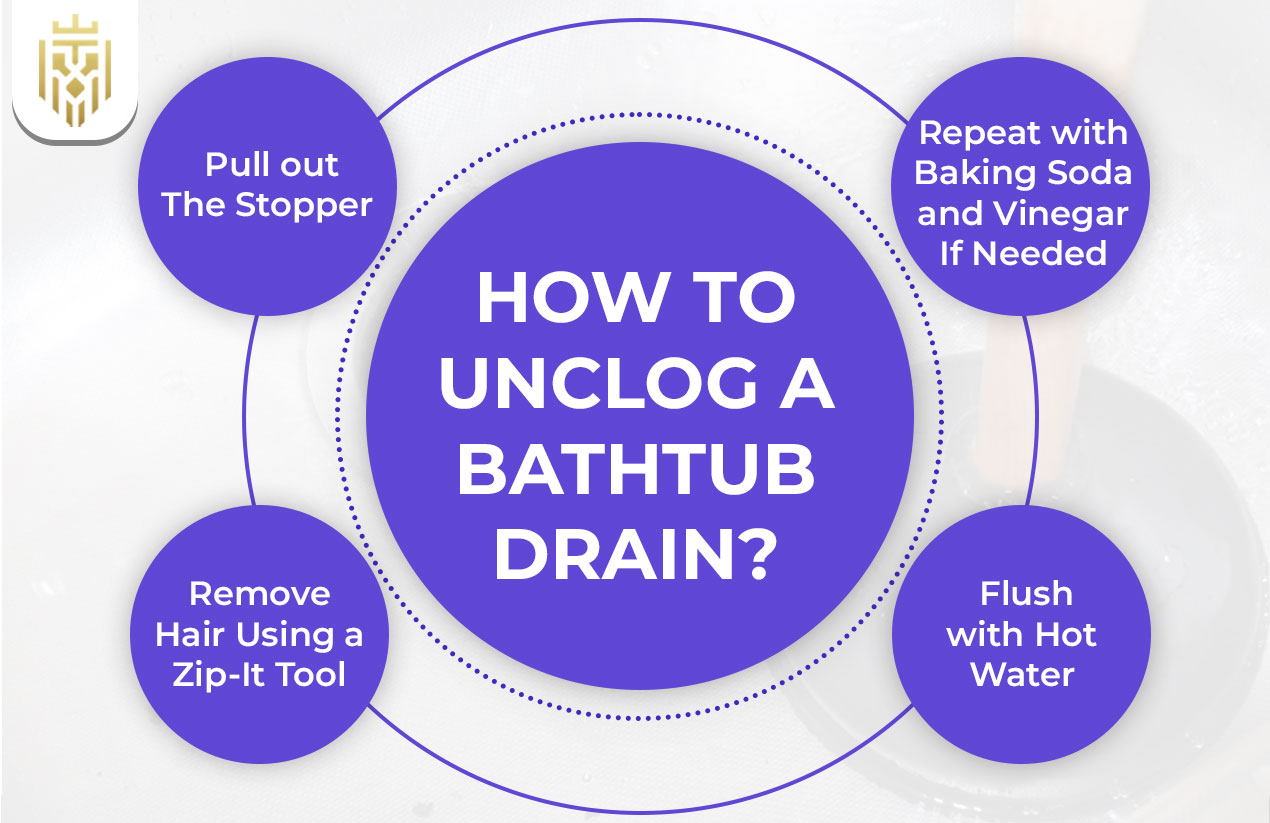
Bathtub drains typically clog up with hair and soap scum. Learning how to unclog a bathtub drain involves both mechanical and natural methods, such as the use of a Zip-It tool, letting in hot water, and using baking soda and vinegar to help keep it clear.
Pull out the Stopper
Pull out the drain stopper to unscrew or lift it out. Hair and dirt often accumulate on the hands. Cleaning up this area is an important job to bear in mind when it comes to learning how to unclog a bathtub drain fast without using chemicals.
Remove Hair Using a Zip-It Tool
One of the most common culprits found in tubs is hair. Take out a Zip-It tool and flab the clump and dislodge it. It does not involve using harsh chemicals, and it leaves the drain clog-free without carrying out several cleaning exercises.
Flush with Hot Water
Once the clog has been removed, push the hot water down the drain in order to melt any residue left behind. The use of this method is decisive in dressing tubs, even when coupled with other natural cleaners such as baking soda to add freshness.
Repeat with Baking Soda and Vinegar If Needed
Once again, use the baking soda and vinegar therapy and repeat the process if the water does not flow rapidly. It is a non-aggressive but effective strategy, and it must also form your usual routine as far as your way of thinking on how to clear a bathtub drain naturally is concerned.
How to Unclog a Bathroom Sink Drain?
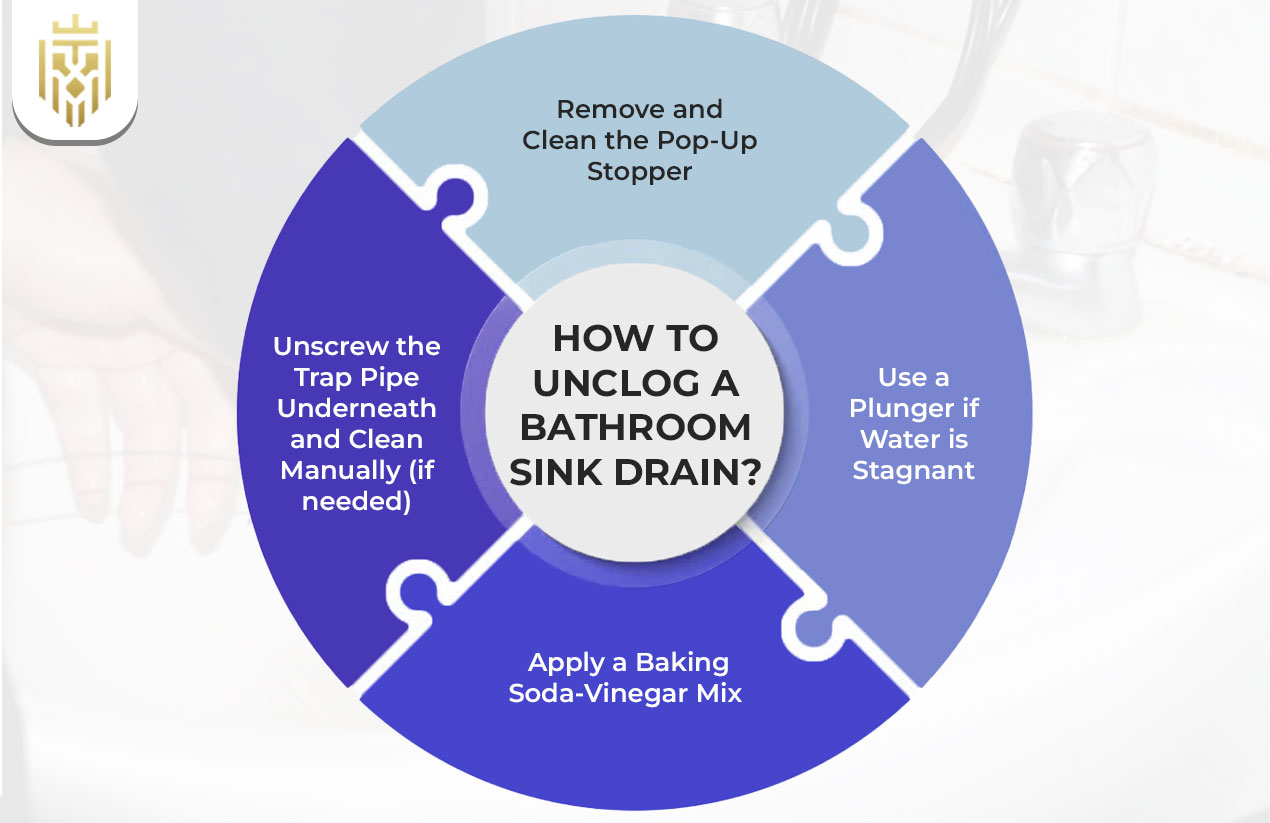
The hair, toothpaste, and soap scum cause clogged bathroom sinks. To unclog a sink drain here, it is necessary to consider efficient cleaning practices such as removing the pop-up, using baking soda, and clearing out the trap by hand to achieve lasting resolutions.
Remove and Clean the Pop-Up Stopper
Hair and debris are trapped in pop-up stoppers. Take it out and scrub it clean. Many times, this is what causes slow draining and needs to be checked first before resorting to a drain cleaner or worse methods, such as taking apart the trap.
Use a Plunger if Water is Stagnant
Over cover a flow and then dive and thump to dislodge a snag. It is an old-school method that is effective, and in cases of bathroom sinks, it comes in handy when trying to unblock a drain without the involvement of a 3rd-party contractor.
Apply a Baking Soda-Vinegar Mix
Add baking soda and then the vinegar into the drain and leave it there. Wash it off in 15 minutes. This combination is useful in deodorizing and clearing the drain without using harsh chemicals that can, at some point, corrode the pipes.
Unscrew the Trap Pipe Underneath and Clean Manually (if needed)
Put a bucket under it, unscrew the trap, and discharge it. This is an efficient way of dealing with stubborn clogs when it comes to learning how to unblock a sink drain, in case the clog is far back and is inaccessible by plungers or home remedies.
FAQs
1) How to Unclog a Drain?
Baking soda and vinegar, boiling water, or even a plunger can remove clogs. No tough chemicals; a drain snake or drain cleaner can be used in case of persistence of the blockage.
2) What Causes Drain Clogs?
Hair, soap scum, food residue, grease, and mineral deposition contribute to the formation of clogs. Such substances clog pipelines, reducing the amount of water passing through; hence, there is a need to decongest the drains in an effective and safe way.
3) How to Unclog a Shower Drain?
Take the cover off, take out the hair, and apply baking soda with vinegar. Wash in hot water. With the skill of how to unblock a shower drain, one can avoid cases where a drain is slow or the source of an odor.
4) How to Unclog a Sink Drain?
Remove the stopper or plunger, or put in a drain snake. Solve it with a vinegar-baking soda solution. Learning to unclog a sink drain is useful in ensuring one clears up problems of food and soap blockages within a short period.
5) How to Unclog a Bathtub Drain?
Pour out the stopper and hair and flush out with hot water. Repeat the same with the baking soda and vinegar, should the need arise. Take some tips on unclogging the bathtub drain without damaging pipes.


